Day 2 of a three day Late Autumn Tour in Norfolk. It was meant to rain all morning, but we saw nothing more than a brief light shower and then the sun came out for the afternoon. Another top quality weather forecast!
To start the morning, we drove along the coast through Cley to Walsey Hills. As we got out of the minibus, a Cetti’s Warbler was singing from the ditch across road. A Little Grebe laughed at us from the edge of Snipes Marsh but when we looked over the reeds we couldn’t see any sign of it. We could see several Gadwall, but there was no way to get a scope on them so we could admire the complexity of the drakes patterned plumage. A scan with binoculars around the edge did however reveal a Kingfisher perched low on the reeds over the far side. A nice way to start the day.
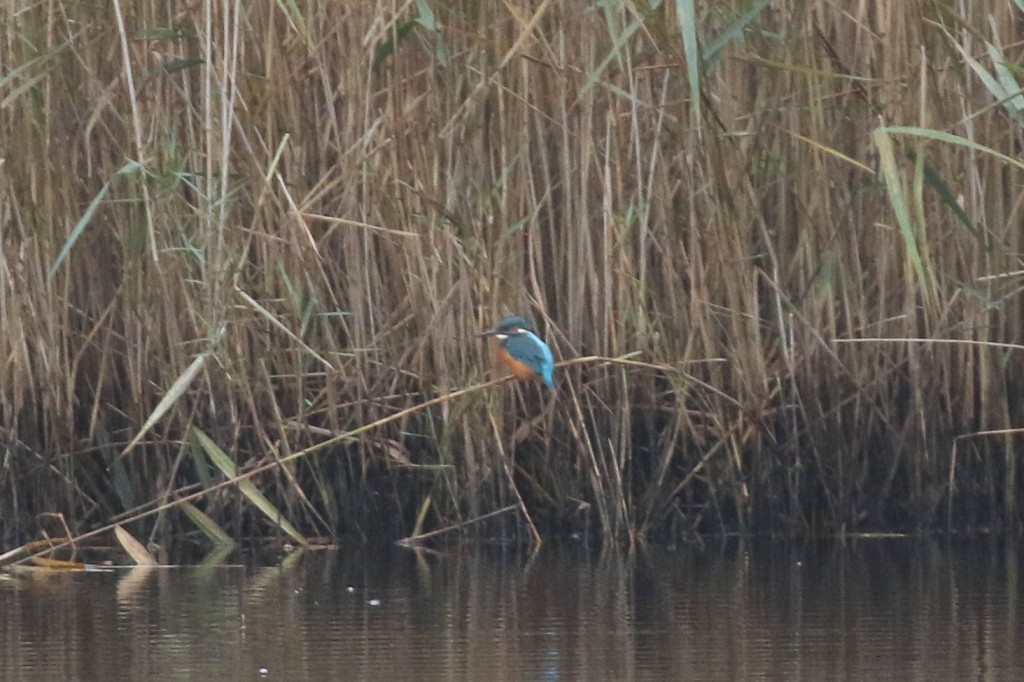
As we walked along the side of the road and up onto the East Bank, a couple of flocks of Starlings and Lapwings flew past us heading inland. More birds on the move today, coming in from the Continent for the winter.
At the start of the East Bank, we stopped to scan. There were several Teal and Mallard on the pool further back in the reedbed. A Marsh Harrier was flushing everything from the scrapes further back. A little further up, we stopped to look at a smart male Shoveler on the near edge of the grazing marsh. The drake was displaying to a female close by, and we then watched them mating.
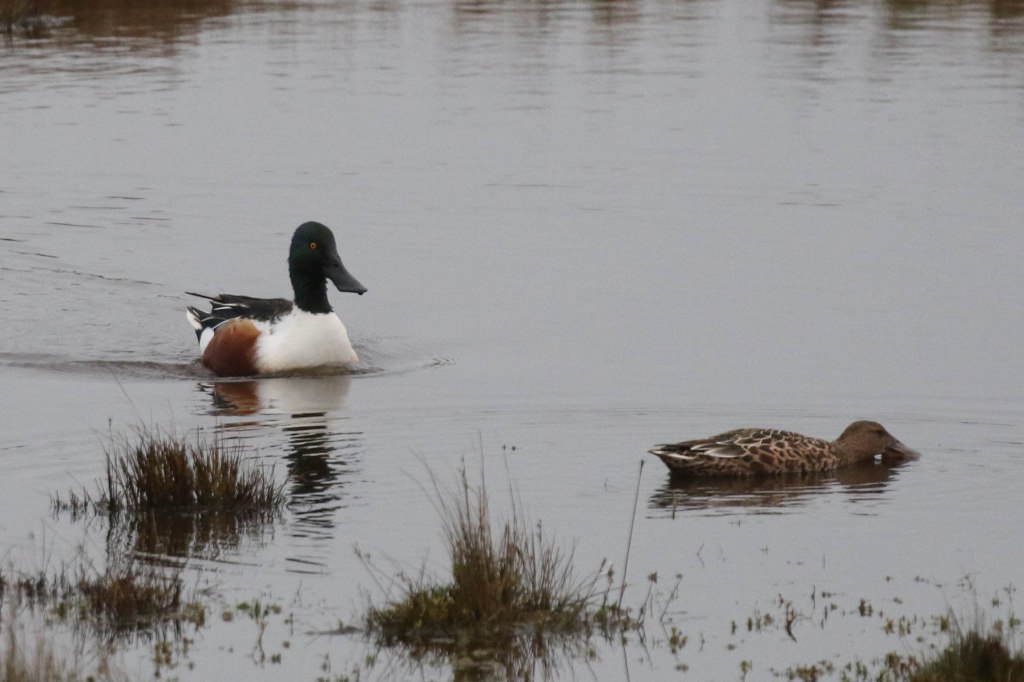
We stopped again by the Serpentine. A single Black-tailed Godwit was feeding down on the edge, which we got in the scope. There were more Wigeon and Teal close to the bank, on the near edge of the water. We had a close look at one of the drake Teal too, just coming out of eclipse.
There were quite a few more Black-tailed Godwits further back on Pope’s Pool, and a single Avocet in with them, until it flew off past us and out over the reeds. Three female Pintail were mostly asleep with several Shoveler in front of the islands where the Cormorants were roosting. A single adult Great Black-backed Gull was in with the Cormorants, and a much smaller and slaty-grey backed Lesser Black-backed Gull was bathing in the water nearby.
Several Marsh Harriers flew in and out of the reedbed beyond – there are over 20 roosting here at Cley at the moment, and presumably some were just stirring. Scanning across we noticed a small bird hovering over the edge of reeds in the distance, in front of Babcock Hide. It landed in the tops and a quick look through the scope confirmed our suspicion – it was a male Stonechat.
Looking further up the East Bank, a Reed Bunting appeared briefly feeding on the edge of the path. While we were watching it, we were distracted by a Kestrel hovering over the bank beyond, which dropped down and caught something. We got it in the scope, perched on the ground, feeding on its prey.
Continuing on up to the north end of Serpentine, a juvenile Ruff was down on the near edge of the water, so we had a quick look at that. It was starting to spit with rain now, so we made for the shelter overlooking Arnold’s. As we arrived, another Ruff dropped in to join a Redshank on the saltmarsh right in front, giving us a very good side-by-side comparison.
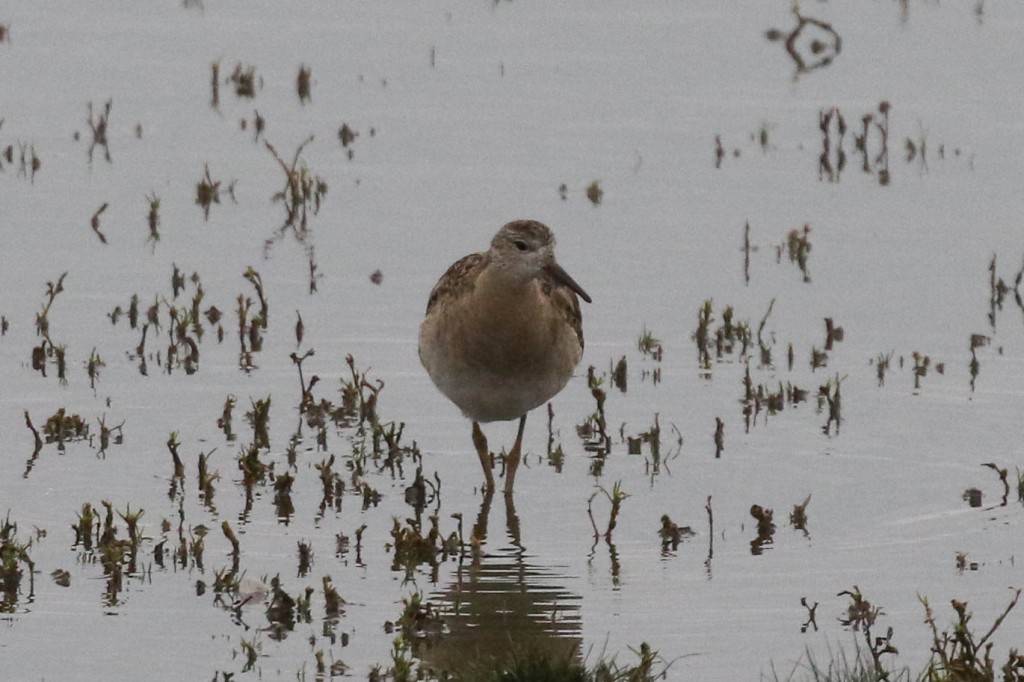
There was a nice selection of waders further back on Arnold’s Marsh, so we worked out way through them in turn – several Dunlin and a couple of Ringed Plovers, three or four Grey Plovers, Curlew, and four Avocets. One of the Avocets at the back was busy feeding, sweeping its bill from side to side in the shallow water. A single drake Pintail was over in the far corner too.
The rain never really got going and quickly stopped, so we headed back out to scan the brackish pool behind. There were more drake Pintail on here, busy upending in the deeper water, showing off their pointed tails, although they have yet to fully regrow their long pin-shaped central tail feathers. There were lots of Shoveler asleep on here too and several Little Grebes along the edge.
Carrying on towards the beach, a very close Curlew down in the pools just below the path looked up at us as we stopped, then decided we didn’t pose any threat and continued feeding. A Grey Heron walked out from the vegetation behind us.
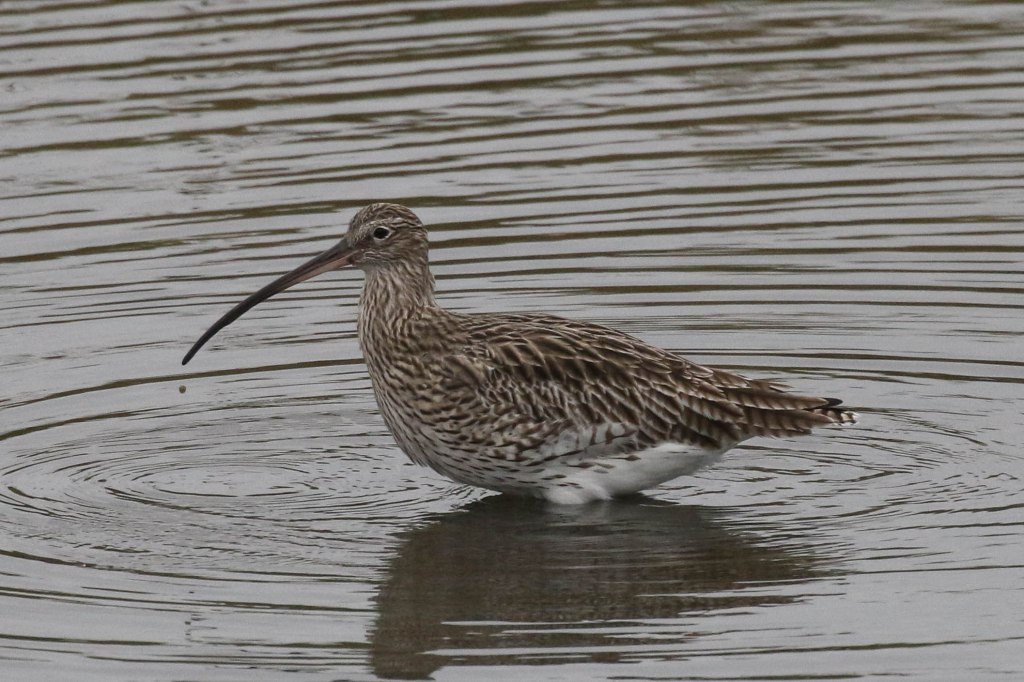
The sea was quite flat today. Several Red-throated Divers were just off the beach, so we got one or two of those in the scopes for a closer look. A Guillemot and Great Crested Grebe were on the sea and and one or two Gannets passed by further offshore.
There were still a few flocks of Starlings coming in over the sea, but the visible migration highlight of the morning was rather different. We picked up two very distant, dark birds, flying east and slowly bearing in towards the shore. Through the scopes, we could see they were two Marsh Harriers – migrants, most likely coming in for the winter. It used to be that Marsh Harriers were just summer visitors here, heading down to southern Europe or West Africa for the winter, but increasingly birds now remain here for the winter and are joined by others coming here from the continent. Great to witness!
After walking back down the East Bank, we had a quick look at the feeders in along the footpath at Walsey Hills. A nice selection of finches and tits popped in and out – Goldfinch, Greenfinch, Chaffinch, Blue Tits, Great Tit and a bonus Coal Tit. After a quick stop to use the facilities at the Visitor Centre, we then then drove east to West Runton.
When we drove down along Beach Road, we could already see the small crowd gathered on the clifftop looking out across a ploughed field, looking at a (Greater) Short-toed Lark. It had been found here yesterday and we had earlier seen the news that it was still present today and ‘showing well’. We parked and walked the small distance along the coast path to join them.
Just as we walked up, all the birds took off from the field and flew round. There was a large flock of Skylarks here and we managed to pick up the single Short-toed Lark in with them as they flew past, noticeably smaller and paler. It landed again out in the middle of the field, but as we got it in the scope we realised that the wind had picked up considerably and it was proving very hard to keep it steady and prevent it from blowing over (looking at the weather data later confirmed that just for a couple of hours around the middle of the day there were gusts of 38-39mph!).
Everything flew again before anyone could get a look through the scope and we lost sight of the Short-toed Lark. As we scanned to try to relocate it, the sun came out too. Normally that would be a thing to celebrate, but it meant we were looking straight into the sunlight, hampering matters further – just when we would have wanted cloud!
A rather frustrating period followed, when we kept getting tantalising glimpses of the Short-toed Lark, but the flock wouldn’t settle for any time in the wind. At one point, it landed very close to us, but we only just had time to get it in the scope before it flew again. Eventually the wind seemed to ease a little and the birds started to settle down a little more. Finally we got some good views of the Short-toed Lark, and some good comparisons with the accompanying Skylarks, larger, darker, more obviously streaked across the breast.
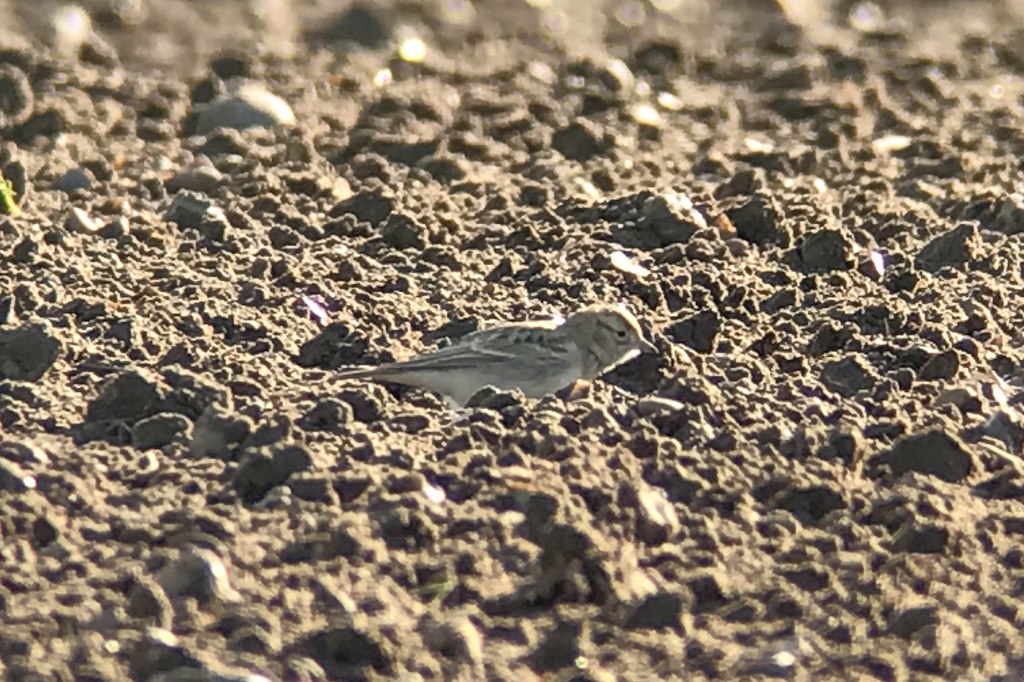
Short-toed Lark is a scarce visitor here from southern Europe, where it spends the summer, regularly overshooting on its way from its wintering grounds in Africa south of the Sahara or wandering here in the autumn. It is more completely titled these days as Greater Short-toed Lark (to distinguish it from Lesser and other short-toed larks), but is still better known by its traditional, shorter name here. This is the first ‘twitchable’ Short-toed Lark to appear in Norfolk for several years, which is why it attracted a steady stream of admirers, us included.
After finally getting good views all round, we walked back to the benches by the beach shelter for a late lunch, looking out over the sea in the sunshine, admiring the House Sparrows on the feeders behind the cafe below and the pair of Dunnocks chasing around the flower beds. It was bright and sunny now but although the wind had dropped a little it was still quite breezy on the coast. With the forecast looking not so good for tomorrow, we decided to head inland to look for Stone Curlews for the remainder of the afternoon today.
After a long drive down to the Brecks, we stopped by the field where we have seen the Stone Curlews regularly in the last few months. A quick scan round the places they have been confirmed that there were none here today, just several Egyptian Geese and Red-legged Partridges here. Thankfully it was not too much of a surprise, as we knew they had been seen somewhere else in the last few days, so we moved quickly on to try there instead.
We took a very short detour back up the road first. As we had driven round here, one of the group had seen a bird of prey attack a Pheasant from the moving minibus right by the road and we thought there was an outside chance it might still be there. Unfortunately, all we found were a few feathers blowing in the breeze!
Then it was back to searching for Stone Curlews. We looked over the hedge where they had been in recent days and there they were. We gradually worked our way along to a gap in the hedge, so as not to disturb them, and set up the scopes to get a closer look. Frame-filling views of a large yellow eye looking back at us!
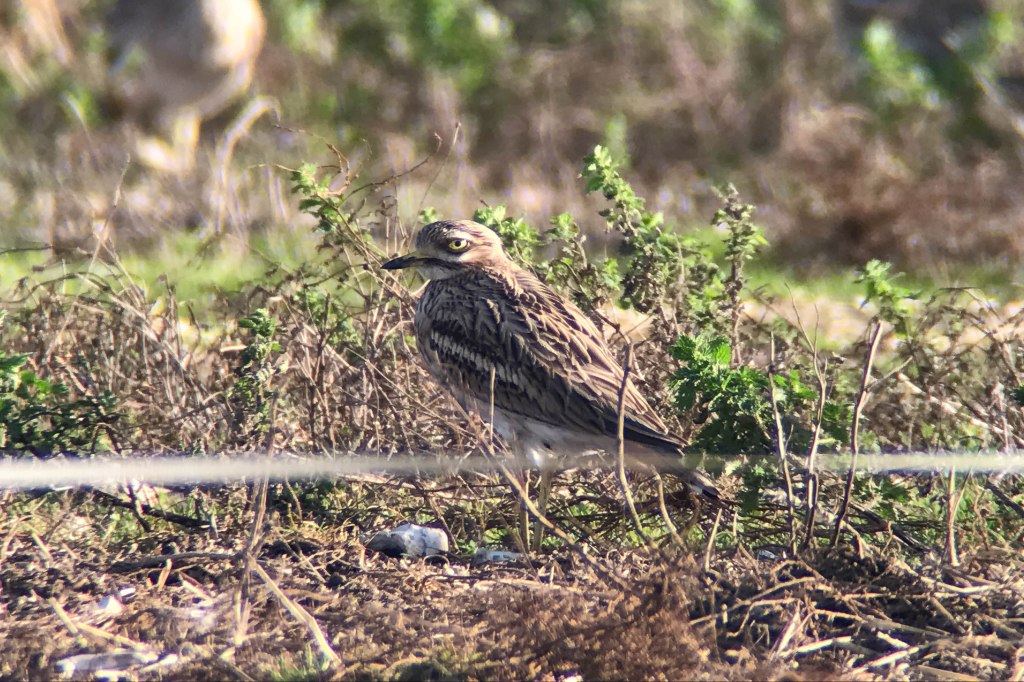
As they grew accustomed to our presence, we could move more out into the open. From here, we could have a better scan and gradually spotted more and more Stone Curlews. We had a maximum count of 26 which we had in view at the same time, but there were probably still quite a few out of view, as birds were moving in and out of the vegetation. There were some great views in the scopes, and it was nice to watch them as they started to move around a little more. A large flock of Linnets was feeding in the weeds nearby.
The Stone Curlews are always one of the highlights of tours at this time of the year, but after we had all had a really good look we still had about half an hour before had to head back. It was still sunny with a fresh breeze and looking around we could see several Buzzards up, so we thought we would have a quick look to see if there were any Goshawks about. We drove to the edge of the forest and stopped overlooking the trees.
When we arrived there were promising signs – three Common Buzzards circled up above the trees and we picked up a Kestrel high overhead. Unfortunately, we were probably just a little late as the sun was starting to drop and the initial activity quickly subsided. A Mistle Thrush flew over and flocks of finches flew in and out of the weedy strip in the field opposite, Chaffinches and Linnets.
It was time to head back now and our main reason for coming down here, to look for Stone Curlews, had been a huge success.
















